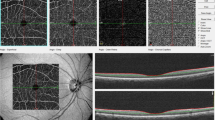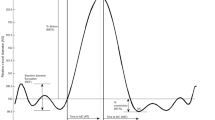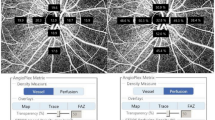Abstract
Masked hypertension is known to induce microvascular complications. However, it is unclear whether early microvascular changes are already occurring in young, otherwise healthy adults. We therefore investigated whether retinal microvascular calibers and acute responses to a flicker stimulus are related to masked hypertension. We used the baseline data of 889 participants aged 20–30 years who were taking part in the African Prospective study on the Early Detection and Identification of Cardiovascular Disease and Hypertension. Clinic and 24-h ambulatory blood pressure were measured. The central retinal artery equivalent (CRAE) and central retinal vein equivalent were calculated from fundus images, and retinal vessel dilation was determined in response to flicker light-induced provocation. A smaller CRAE was observed in those with masked hypertension vs. those with normotension (157.1 vs. 161.2 measuring units, P < 0.001). In forward multivariable-adjusted regression analysis, only CRAE was negatively related to masked hypertension [adjusted R2 = 0.267, β = −0.097 (95% CI = −0.165; −0.029), P = 0.005], but other retinal microvascular parameters were not associated with masked hypertension. In multivariable logistic regression analyses, masked hypertension [OR = 2.333, (95% CI = 1.316; 4.241), P = 0.004] was associated with a narrower CRAE. In young healthy adults, masked hypertension was associated with retinal arteriolar narrowing, thereby reflecting early microvascular alterations known to predict cardiovascular outcomes in later life.
This is a preview of subscription content, access via your institution
Access options
Subscribe to this journal
Receive 12 print issues and online access
$259.00 per year
only $21.58 per issue
Buy this article
- Purchase on Springer Link
- Instant access to full article PDF
Prices may be subject to local taxes which are calculated during checkout
Similar content being viewed by others
References
World Health Organization. Global health risks: mortality and burden of disease attributable to selected major risks. World Health Organization. 2009. https://apps.who.int/iris/handle/10665/44203.
O’Brien E, Parati G, Stergiou G, Asmar R, Beilin L, Bilo G, et al. European Society of Hypertension Working Group on Blood Pressure Monitoring. Guidelines European Society of Hypertension Position Paper on Ambulatory Blood Pressure Monitoring. J Hypertens. 2013;31:1731.
Parati G, Stergiou G, O’Brien E, Asmar R, Beilin L, Bilo G, et al. European Society of Hypertension practice guidelines for ambulatory blood pressure monitoring. J Hypertens. 2014;32:1359–66.
Williams B, Mancia G, Spiering W, Agabiti Rosei E, Azizi M, Burnier M, et al. 2018 ESC/ESH guidelines for the management of arterial hypertension. Eur Heart J. 2018;39:3021–104.
Banegas JR, Ruilope LM, de la Sierra A, Vinyoles E, Gorostidi M, de la Cruz JJ, et al. Relationship between clinic and ambulatory blood-pressure measurements and mortality. N Engl J Med. 2018;378:1509–20.
Franklin SS, O’brien E, Staessen JA. Masked hypertension: understanding its complexity. Eur Heart J. 2017;38:1112–8.
Hänninen M-RA, Niiranen TJ, Puukka PJ, Kesäniemi YA, Kähönen M, Jula AM. Target organ damage and masked hypertension in the general population: the Finn-Home study. J Hypertens. 2013;31:1136–43.
Routledge FS, McFetridge-Durdle JA, Dean C. Night-time blood pressure patterns and target organ damage: a review. Can J Cardio. 2007;23:132–8.
Moss HE. Retinal vascular changes are a marker for cerebral vascular diseases. Curr Neurol Neurosci Rep. 2015;15:40.
Lim M, Sasongko MB, Ikram MK, Lamoureux E, Wang JJ, Wong TY, et al. Systemic associations of dynamic retinal vessel analysis: a review of current literature. Microcirculation. 2013;20:257–68.
Al-Fiadh AH, Wong TY, Kawasaki R, Clark DJ, Patel SK, Freeman M, et al. Usefulness of retinal microvascular endothelial dysfunction as a predictor of coronary artery disease. Am J Cardiol. 2015;115:609–13.
Nagel E, Vilser W, Lanzl I. Age, blood pressure, and vessel diameter as factors influencing the arterial retinal flicker response. Invest Ophthalmol Vis Sci. 2004;45:1486–92.
Kotliar KE, Lanzl IM, Schmidt-Trucksäss A, Sitnikova D, Ali M, Blume K, et al. Dynamic retinal vessel response to flicker in obesity: a methodological approach. Microvasc Res. 2011;81:123–8.
McGeechan K, Liew G, Macaskill P, Irwig L, Klein R, Klein BE, et al. Meta-analysis: retinal vessel caliber and risk for coronary heart disease. Ann Intern Med. 2009;151:404–13.
Seidelmann SB, Claggett B, Bravo PE, Gupta A, Farhad H, Klein BE, et al. Retinal vessel calibers in predicting long-term cardiovascular outcomes: the atherosclerosis risk in communities study. Circulation. 2016;134:1328–38.
Yatsuya H, Folsom AR, Wong TY, Klein R, Klein BE, Sharrett AR. Retinal microvascular abnormalities and risk of lacunar stroke: Atherosclerosis Risk in Communities Study. Stroke. 2010;41:1349–55.
Triantafyllou A, Doumas M, Anyfanti P, Gkaliagkousi E, Zabulis X, Petidis K, et al. Divergent retinal vascular abnormalities in normotensive persons and patients with never-treated, masked, white coat hypertension. Am J Hypertens. 2013;26:318–25.
Wei F-F, Zhang Z-Y, Thijs L, Yang W-Y, Jacobs L, Cauwenberghs N, et al. conventional and ambulatory blood pressure as predictors of retinal arteriolar narrowing. Hypertension. 2016;68:511–20.
Schutte AE, Gona PN, Delles C, Uys AS, Burger A, Mels CM, et al. The African Prospective study on the Early Detection and Identification of Cardiovascular disease and Hypertension (African-PREDICT): design, recruitment and initial examination. Eur J Preventive Cardiol. 2019;26:458–70.
Mokwatsi GG, Schutte AE, Mels CMC, Kruger R. Morning blood pressure surge in young black and white adults: the African-PREDICT Study. J Hum Hypertens. 2019;33:22–33.
Marfell-Jones MJ, Stewart A, De Ridder J. International standards for anthropometric assessment. International standards for anthropometric assessment. Wellington, New Zealand: International Society for the Advancement of Kinanthropometry. 2012.
Kotliar K, Hauser C, Ortner M, Muggenthaler C, Diehl-Schmid J, Angermann S, et al. Altered neurovascular coupling as measured by optical imaging: a biomarker for Alzheimer’s disease. Sci Rep. 2017;7:12906.
Malan L, Hamer M, Von Känel R, Schlaich MP, Reimann M, Frasure-Smith N, et al. Chronic depression symptoms and salivary NOx are associated with retinal vascular dysregulation: the SABPA study. Nitric Oxide. 2016;55:10–7.
Liew G, Wong TY, Mitchell P, Wang JJ. Are narrower or wider retinal venules associated with incident hypertension? Hypertension. 2006;48:e10.
Liew G, Sharrett AR, Kronmal R, Klein R, Wong TY, Mitchell P, et al. Measurement of retinal vascular caliber: issues and alternatives to using the arteriole to venule ratio. Invest Ophthalmol Vis Sci. 2007;48:52–7.
Leung H, Wang JJ, Rochtchina E, Tan AG, Wong TY, Klein R, et al. Relationships between age, blood pressure, and retinal vessel diameters in an older population. Invest Ophthalmol Vis Sci. 2003;44:2900–4.
Wong TY, Klein R, Klein BE, Meuer SM, Hubbard LD. Retinal vessel diameters and their associations with age and blood pressure. Invest Ophthalmol Vis Sci. 2003;44:4644–50.
Hata J, Fukuhara M, Sakata S, Arima H, Hirakawa Y, Yonemoto K, et al. White-coat and masked hypertension are associated with albuminuria in a general population: the Hisayama Study. Hypertens Res. 2017;40:937.
Nagel E, Vilser W, Fink A, Riemer T, Lanzl I. Blood pressure effects on retinal vessel diameter and flicker response: a 1.5-year follow-up. Eur J Ophthalmol. 2006;16:560–5.
Mandecka A, Dawczynski J, Blum M, Müller N, Kloos C, Wolf G, et al. Influence of flickering light on the retinal vessels in diabetic patients. Diabetes Care. 2007;30:3048–52.
Voets T, Nilius B. TRPCs, GPCRs and the Bayliss effect. EMBO J. 2009;28:4–5.
Seifert B-U, Vilser W. Retinal Vessel Analyzer (RVA)-design and function. Biomed Tech. 2002;47:678–81.
Seshadri S, Ekart A, Gherghel D. Ageing effect on flicker‐induced diameter changes in retinal microvessels of healthy individuals. Acta Ophthalmol. 2016;94:e35–42.
Newman EA. Functional hyperemia and mechanisms of neurovascular coupling in the retinal vasculature. J Cereb Blood Flow Metab. 2013;33:1685–95.
Noonan JE, Lamoureux EL, Sarossy M. Neuronal activity‐dependent regulation of retinal blood flow. Clin Exp Ophthalmol. 2015;43:673–82.
Acknowledgements
The authors are indebted to all participants, students, and support and research staff. The financial support received from the DAAD/National Research Foundation, South Africa, is appreciated.
Funding
This research is part of an ongoing project financially supported by the South African Medical Research Council (SAMRC), with funds provided by the following: the National Treasury, under its Economic Competitiveness and Support Package; the South African Research Chairs Initiative (SARChI) of the Department of Science and Technology and National Research Foundation (NRF; UID86895 and 115354) of South Africa; the South African National Department of Health, GlaxoSmithKline R&D (Africa Non-Communicable Disease Open Lab grant); the UK Medical Research Council, with funds from the UK Government’s Newton Fund; corporate social investment grants from Pfizer (South Africa), Boehringer-Ingelheim (South Africa), Novartis (South Africa), the Mediclinic Hospital Group (South Africa); and in-kind contributions from Roche Diagnostics (South Africa). Any opinion, findings, conclusions, or recommendations expressed in this article are those of the authors, and the NRF does not accept any liability in regard thereto.
Author information
Authors and Affiliations
Corresponding author
Ethics declarations
Conflict of interest
The authors declare that they have no conflict of interest.
Additional information
Publisher’s note Springer Nature remains neutral with regard to jurisdictional claims in published maps and institutional affiliations.
Rights and permissions
About this article
Cite this article
Ramoshaba, N.E., Huisman, H.W., Lammertyn, L. et al. Retinal microvasculature and masked hypertension in young adults: the African-PREDICT study. Hypertens Res 43, 1231–1238 (2020). https://doi.org/10.1038/s41440-020-0487-0
Received:
Revised:
Accepted:
Published:
Issue Date:
DOI: https://doi.org/10.1038/s41440-020-0487-0



